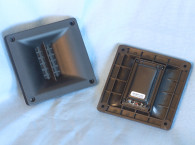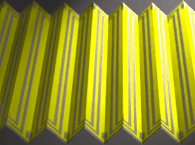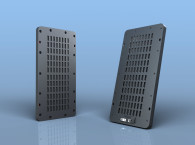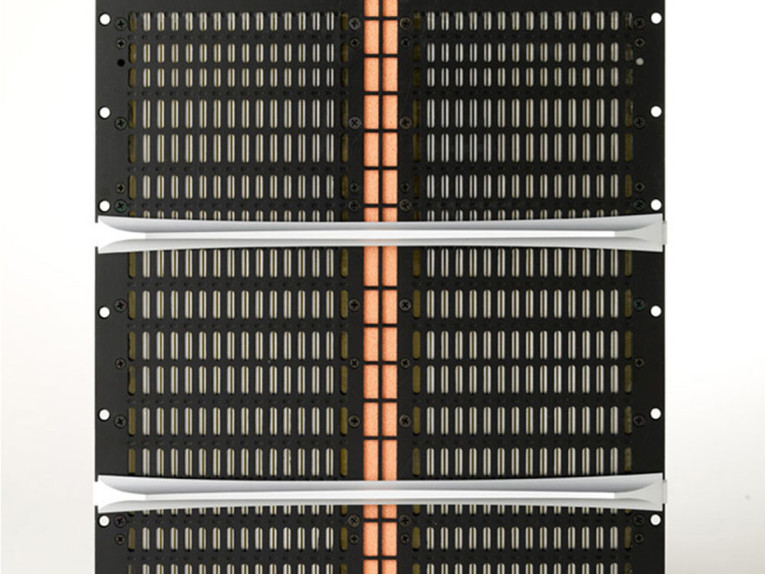
Thin Diaphragms
The key mechanism in thin-film drivers is a very thin diaphragm made from polymer film/aluminum foil laminate (or just pure aluminum foil ribbon) that is uniformly driven more or less by either electrostatic (based on forces acting on electric charge in electric field) or electro-magnetic (using Lorentz force on a current-carrying conductor in a magnetic field) motor system. Such diaphragms have extremely low mass, comparable with the mass of air load, vibrating along with the diaphragm. Mechanical and electro-acoustical mechanisms and relationships in those drivers differ in some fundamental ways from typical common cone or dome drivers.
Traditional drivers are, in general, a very good universal solution for a wide range of applications that has been tested by time. The first cone-based electrodynamic driver was invented by Chester Rice and Edward Kellogg at General Electric in 1925, and in principle remains the same to this day. However, as almost always in audio, gains in one area require compromises in other areas. Thin-film drivers do not possess universality, they are very challenged when it comes to the reproduction of low-frequency signals. Some electrostatic and large panel planar designs lack ruggedness and are not suitable for certain applications. They may have limited dynamic range and often have compromised dispersion characteristics.
On the other hand, since thin-film drivers can compromise on ultimate universality and applicability for the most demanding pro applications or bass reproduction, they get the advantage of using different principles and design solutions. Thin-film transducers use different technology and materials that provide less distortion and, in many cases, enable them to achieve better sound quality than voice coil-based drivers, which have a “burden” to meet requirements in universality, extreme output levels, ease of mass production, low cost, and so forth.
The fundamental advantage that thin-film drivers possess over typical electrodynamic drivers is that they do not use round voice coils with multiple wire-turns immersed in a magnetic gap. Such motors tend to have high inductance and magnet systems that are not symmetric and are prone to magnetic hysteresis, Eddy currents, and a slew of nonlinearities associated with inductance modulation when voice coil dynamically moves in the magnetic gap.
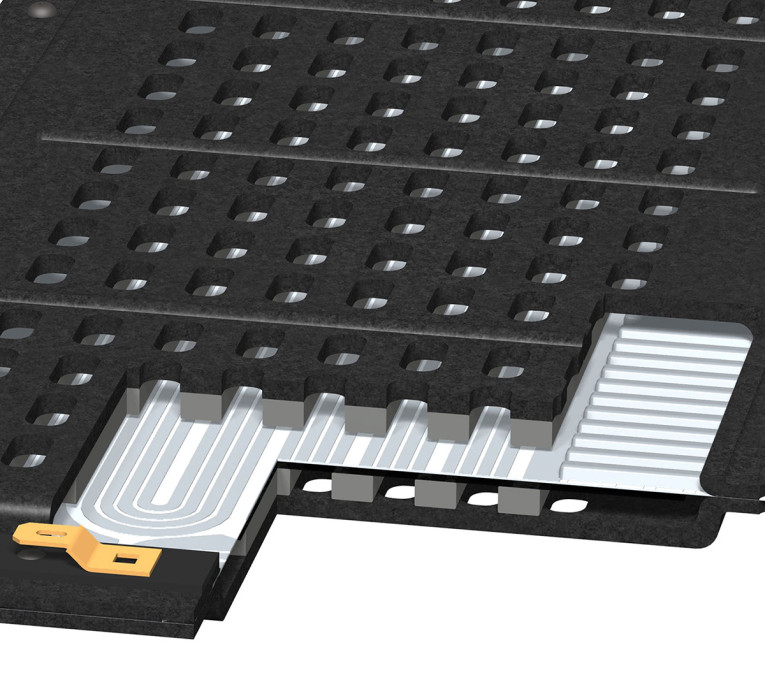
Research Work
Several breakthrough research works conducted over the past 20 or so years analyzed the nature and identified causes of nonlinearities in loudspeakers based on new approaches, techniques, and tools. We make reference to several major research works here, but there is a number of others that point to similar results.
In articles that Dr. Wolfgang Klippel wrote for the Audio Engineering Society (AES) [1], [2] and many other related articles and presentations, he specifically points out that nonlinearities associated with voice coil inductance and modulation of flux B in magnetic gap are predominant distortion mechanisms in speakers.
Those distortion components manifest themselves in much wider frequency ranges than nonlinearities related to displacement dependent nonlinearity of suspension stiffness Kms(x) and motor force Bl(x), which mostly dominate below and slightly above fundamental driver resonance Fs. Nonlinearity of such transducer parameters as Le(i) inductance vs. current, Le(x) inductance vs. displacement, and Bl(i) motor force, play major roles in generating distortions above driver resonance and at all signal levels even at the lowest ones. For many dome tweeters, however, the Kms(x) nonlinearity is inherent, even at low levels since they have a single-roll suspension that is always asymmetric and its nonlinearity is more prevalent since it is not compensated by spider dominant compliance (usually more linear) at small displacements.
Alex Voishvillo — in his extensive range of papers [3],[4] and other presentations on nonlinearity in speakers, their audibility, and the latest methods of measurements and assessment—clearly shows distortion that manifests itself at low and moderate signal levels is easily noticeable and the most objectionable. Similar conclusions are reported by Earl Geddes and Lidia Lee [5].
This has to do with the fact that music, unlike sine wave test tones, has signal amplitude probability distribution with peaks occurring rather infrequently, while lower-level signals are present in program material most of the time. In other words, the lower the level of the signal, the higher the frequency of its occurrence. That is why distortion components that we observe only at higher levels are very often benign (up to a point), since they are masked by higher-level signals that generate those distortions in the first place. Those are typically generated by suspension stiffness Kms(x) limiting (some dome tweeters have Kms(x) nonlinearity at low level as well) and the voice coil getting out of the magnetic gap, generating Bl(x) nonlinearity.
On the other hand, distortions related to Le(i), Le(x), Bl(i), and cone/dome mechanical break-up are generated at all signal levels and in a very wide frequency band. Such distortions, without the presence of strong masking signals, often extend beyond the masking band (difference, parametric, higher-order nonlinearities, and many intermodulation components). That’s when they become very audible. The key here is that the masking effect depends on the level of the masking signal. The lower the signal, the weaker the masking effect and the more acute our ability to perceive distortions.
Our ear perceives low-level signals with much greater acuteness and resolution. This is a very strong survival mechanism that humans developed over a very long time. Besides, low-level signals and associated distortions are very easy to discern since there is no masking effect present. This explains why having low distortion at moderate and low levels is crucial for sound quality.
For years, audio experts and enthusiasts paid attention to low-level signal resolution and signal detail retrieval. In fact, this quality is one of the main criteria for high-end systems' differentiation from budget and mass products. From the early days of digital audio, disappointing sound quality of CDs was associated with quantization error and low-level digital noise. We were promised the perfect sound forever and there were claims that distortions would be vanishingly small to non-existent, and yet, many early CDs sounded uninvolving, to say the least. Later, dither was introduced to reduce low-level noise and distortion. Even earlier, before digital, audio professionals noticed that transistor amplifiers, claiming an extremely low percentage of zero-crossing distortion, sounded very unpleasant.
On paper, they may have had rather low total harmonic distortion (THD) levels, but since those distortions were generated at low level input signals, they were very noticeable. No wonder, that many high-end amplifier manufacturers religiously choose Class-A topology even though it is very inefficient and limited in power. A Class-A amplifier has an extremely linear performance at low level input signals and this is what really matters for sound quality.

Comparing Drivers
Getting back to thin-film transducers, as with many other technical challenges, we see that once we narrow applicability and accept certain compromises (bass performance, costs, ease of mass production, etc.), and instead focus on low distortion, both linear and nonlinear, we can use thin-film drivers’ fundamental advantages to serve us in the pursuit of ultimate sound quality. Thin-film drivers/speakers are represented by several different and distinct types.
Electrostatic Speakers — There are some die-hard proponents of electrostats and that’s understandable. When it comes to midrange reproduction, the best Quads and a few other best electrostatic speakers can deliver superb transparency, if they are set up correctly in a suitable room.
However, it is very difficult to do so since all electrostatic speakers, as well as all large planar magnetic panels, despite various efforts, have very irregular dispersion pattern, lobing effects, and so forth. This makes them very sensitive to setup conditions and the “sweet spot” may be rather limited in size. Besides, extra thin and very large Mylar/aluminum film tends to deteriorate with time and lose its tensioning. The aluminum layer in electrostatic diaphragm is less than one micron thick and is subject to arcing, metal drop outs, and corrosion (in the long term).
Electrostatic speakers have limitations in their dynamic range as well and require bass augmentation, which is very difficult to do right, due to many differences in driver characteristics and radiation patterns.

Large Planar Magnetic Speakers (Apogee, Magnepan) — These transducers can produce an amazing mid-range sound as well and can create a magnificent and palpable soundscape, which in the right setup could be stunning. However, as with electrostats, they have irregular dispersion due to their large size, limited dynamic range, and they require woofers to augment their limited bass with the same set of integration challenges as mentioned above.
Not many people realize that all elongated thin-film speakers are not point sources but rather are extended line sources at least in mid-frequency and high-frequency bands. The same is fully applicable to popular discrete line arrays. As such, they do not follow a typical inverse square law of sound pressure level (SPL) drop off with distance.
To further complicate things, this drop off is frequency dependent. In most domestic conditions, listeners are positioned in the near field of those sources where their behavior is very complicated and varies dramatically in space and frequency.
In other words, frequency response of such devices will vary with distance and position of a listener. There are no two spots in space with identical SPL response. To find that magic reference spot with truly balanced sound is often a challenging task for a listener. At any different spot such system will sound different. In practice, room reflections and reverberation help to alleviate this problem and make such systems often sound big and spectacular, but the technical problem remains and could be a subject for discussion and arguments.
Aluminum foil ribbon tweeters (pure ribbon) — Pioneered by Stanley Kelly at London Decca, these designs use an extremely thin corrugated aluminum foil strip suspended in a relatively weak magnetic field and require an impedance matching transformer. There are only a few designs that are exceptionally good and have superbly transparent and delicate high-frequency reproduction. Those are extremely expensive (RAAL), since such devices are difficult to manufacture with reliable consistency. They are rather fragile and the foil can easily lose its geometric stability over time or when overdriven. They also have relatively limited dynamic range. In order not to jeopardize efforts of super expensive speaker cable enthusiasts, such devices should probably use a special wire in their transformers to avoid cable controversy.

Air motion transformer drivers, (AMT, ESS Heil) — Invented by Dr. Oskar Heil, these very interesting designs proved to be more reliable and usable in domestic and even some light pro applications (studio monitors) since they do not require a matching transformer and use a laminated diaphragm with polymer substrate instead of thin aluminum foil. The original ESS Heil driver was a special device with unusually clear, low distortion sound for that time. It was large, heavy, and its integration with low-frequency drivers was... challenging.
Today, there are many very good AMT tweeters and they have become very popular. As in the original ESS design, they use a folded “accordion” diaphragm, but their magnetic system is much simpler, leveraging small high MGO neodymium magnets or magnetic steel poles, positioned in the front and at the back perpendicular to the conductors. Small AMTs, especially the ones made in Asia, have been rather cost effective and successfully compete with dome tweeters even in budget markets.
And yet, if we look at AMTs with a magnifying glass and ultimate sound quality in mind, we can clearly see some drawbacks. A typical problem for high-output applications is limited power since the conductors are very close to each other and there is no metal in proximity to draw heat away.
Recent designs use a polyimide (Kapton) diaphragm to mitigate this to some extent, but the early onset of power compression is still typical. Even though the Kapton could handle higher temperatures, the folded accordion quickly gets heated and then its shape distorts generating internal stresses and distortion.
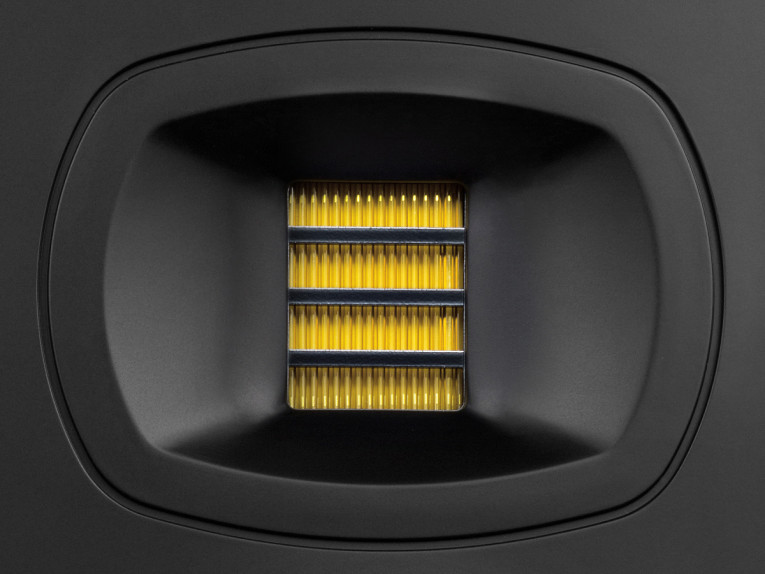
Designs that aim at higher power and a lower crossover point use larger diaphragms. The width of such a diaphragm could be wider than 1" and/or longer than 3", which results in high-frequency beaming with an extremely narrow vertical coverage above about 8 kHz. This puts a listener in a very restricted sweet spot.
The folded diaphragm has an accordion pattern and its vibrations are naturally nonlinear. While lateral displacements of the fold walls are more or less linear (at least at lower levels), the radiating area of the exit of each fold changes (“breathes”), which is inherently a nonlinear effect. When folds are moving inward, “squeezing” air, the exit area grows smaller, and when folds move apart, the radiating area gets larger. Thus, we can see a clear modulation effect.
Higher levels would require larger displacements where air in the narrow folds becomes nonlinear and viscous, leading to higher losses/compression and intermodulation. Yet another design feature is that the magnetic field from bar magnets or steel poles, which are located across conductors, is only partially crossing the conductors.
Approximately 50% of the conductor is closed by magnets and about 50% has an opening for sound to exit, where there is no magnetic flux or it is very much reduced to a stray field. This results in an uneven driving force distribution and leads to various forms of distortion. Yet another problem is that the way an AMT diaphragm is folded and kept in position does not reliably provide the same form factor and position for the folds and the conductors, which increases deviation of parameters from unit to unit.
And yet, those drivers are becoming very popular, which tells us that our “hearing apparatus” could be very forgiving to certain types of distortion, especially if they take place mostly at higher levels and are absent at lower levels as is the case with AMTs.
Planar ribbon drivers (ribbon, planar-magnetic, and isodynamic) — These designs have the least problems within their thin-film transducer family and over the years have proven to be the most universal, combining superior sound quality, the widest application range, reasonable costs, and reliability that grants them use in various professional markets.
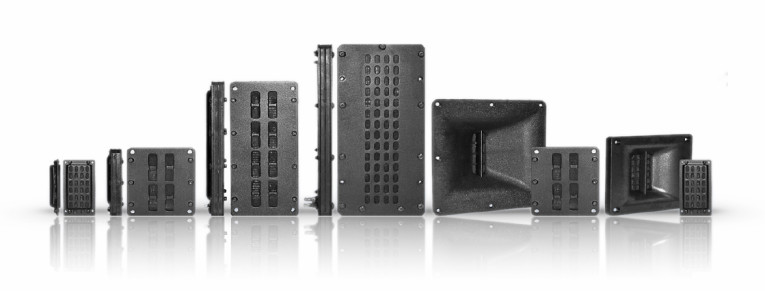
There are several major/visible brand names currently operational that are the best representatives of a wide application range of this technology. Alcons (formerly Stage Accompany engineers), Dolby’s speaker division (formerly SLS Audio), and Vive Audio (a Christie Digital subsidiary in commercial cinema born out of an acquisition of BG Radia) in the pro market; Wisdom Audio in the high-performance residential; Coastal Source and Ambisonic Systems in the outdoor market; and Radian Audio Engineering (an OEM driver supplier to both markets).
In the second part of this article, I will look at the detailed design aspects of the Radian LT2/LT6 ribbon transducers and their specific advantages. VC
This article was originally published in Voice Coil, August 2020




